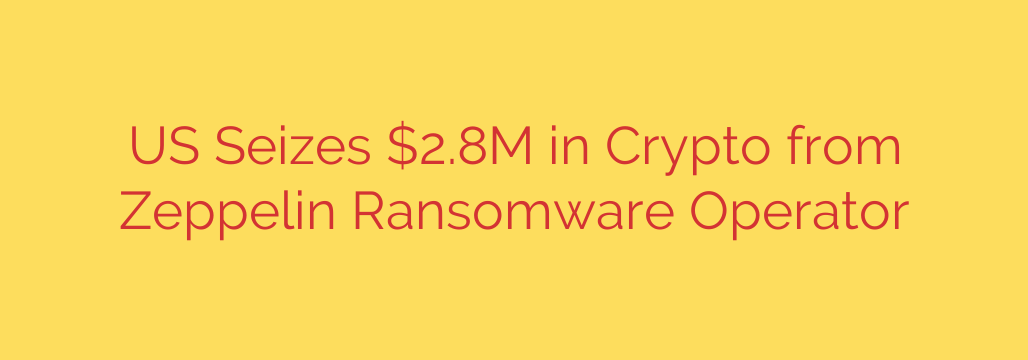
U.S. Government Seizes $2.8 Million in Crypto from Zeppelin Ransomware Operator
In a significant victory against cybercrime, U.S. law enforcement agencies have successfully seized approximately $2.8 million in cryptocurrency linked to the notorious Zeppelin ransomware gang. The operation, led by the FBI, targeted a key operator of the group, disrupting its financial network and sending a clear message to cybercriminals that digital assets are not a safe haven for illicit funds.
The forfeiture complaint, recently unsealed, details the seizure of Bitcoin (BTC) and Tether (USDT) from an account controlled by a Ukrainian national, Mark Sokolovsky. Sokolovsky, who allegedly used aliases such as “iKala” and “FANCY,” is accused of being a central figure in the development and deployment of the Zeppelin ransomware.
This action highlights the increasing capability of federal investigators to trace and reclaim ransom payments, even when they are laundered through complex cryptocurrency transactions.
What is Zeppelin Ransomware?
Zeppelin is a dangerous and aggressive strain of ransomware that operates on a Ransomware-as-a-Service (RaaS) model. In a RaaS scheme, developers create the malicious software and then lease it to affiliates, who carry out the attacks in exchange for a share of the profits.
This model allows ransomware to spread rapidly, as it lowers the technical barrier for would-be criminals to launch devastating attacks. The Zeppelin gang has been known to target a wide range of victims, including:
- Critical infrastructure providers
- Healthcare and medical institutions
- Technology companies
- Educational institutions
Once a network is compromised, Zeppelin encrypts critical files, rendering them inaccessible. The attackers then demand a substantial ransom payment, typically in cryptocurrency, in exchange for a decryption key. Failure to pay often results in the permanent loss of data or the threat of leaking sensitive information online.
Following the Digital Trail to Justice
The success of this operation hinged on the FBI’s ability to meticulously follow the flow of funds on the blockchain. While cybercriminals often believe that cryptocurrencies like Bitcoin offer complete anonymity, law enforcement has developed sophisticated tools and techniques to de-anonymize transactions.
Investigators were able to trace ransom payments from multiple victims directly to cryptocurrency wallets controlled by Sokolovsky. This digital paper trail provided the crucial evidence needed to link the operator to the crimes and justify the seizure of the assets. The action serves as a stark reminder that the perceived anonymity of crypto is fading, and illicit funds can be tracked and confiscated.
A Major Blow to Ransomware Operations
Seizing the financial assets of ransomware groups is one of the most effective strategies for dismantling their operations. By cutting off their access to profits, authorities disrupt the core incentive for these attacks. This $2.8 million seizure directly impacts the Zeppelin group’s ability to fund future development, pay affiliates, and sustain its infrastructure.
This case demonstrates a clear commitment from global law enforcement to pursue threat actors wherever they operate and to deny them the profits of their crimes.
How to Protect Your Organization from Ransomware Attacks
While law enforcement is making significant strides, the primary responsibility for defense still lies with organizations. Proactive cybersecurity measures are the best defense against Zeppelin and other ransomware threats.
Here are essential, actionable steps every business should take:
- Implement a Robust Backup Strategy: Regularly back up all critical data using the 3-2-1 rule: three copies of your data, on two different media types, with one copy stored off-site and offline. Test your backups frequently to ensure they can be restored successfully.
- Keep Software and Systems Patched: Ransomware often exploits known vulnerabilities in software. Ensure that all operating systems, applications, and security software are consistently updated with the latest patches.
- Enhance Email Security: Phishing emails are a primary entry point for ransomware. Use advanced email filtering to block malicious attachments and links, and train employees to recognize and report suspicious messages.
- Enforce Strong Access Controls: Implement the principle of least privilege, ensuring users only have access to the data and systems necessary for their jobs. Require Multi-Factor Authentication (MFA) for all remote access, email, and critical system accounts.
- Develop an Incident Response Plan: Don’t wait for an attack to happen. Create a clear, actionable plan that outlines the steps to take during a security incident, including who to contact, how to isolate affected systems, and when to engage law enforcement.
Source: https://www.bleepingcomputer.com/news/security/us-seizes-28-million-in-crypto-from-zeppelin-ransomware-operator/








